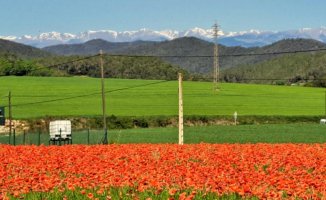The president of the Confederation of Entrepreneurs of the Valencian Community (CEV), Salvador Navarro, recalled yesterday that practically nothing had been invested in the Sagunt-Teruel-Zaragoza line since 1919. "Before there were four trains a week and when it rained, the train had to go to Tarragona because with the water, the tracks slipped," said Navarro during his speech at the forum promoting the Cantabrian-Mediterranean corridor held in Zaragoza.
It was the anecdote that he contributed to the protest act that brought together businessmen from both regions, infrastructure managers such as the president of Adif, and politicians, such as the presidents of Aragón and the Valencian Community, Javier Lambán and Ximo Puig, at the headquarters of CEOE Aragón. Both showed harmony in claiming an infrastructure that unites them, but they also influenced the "peripheral look", in going beyond Madrid or Barcelona, an argument that the business community also included in its premises.
Thus, Ximo Puig celebrated that the road has new investments, but, he said, "we want it to go faster, without centralist myopia or outdated realities." For the Valencian president, infrastructure decisions "are never neutral" and pointed out that an effort must be made to electrify this line because the Valencian Community, Aragon, Navarra, La Rioja, the Basque Country and Cantabria concentrate 22% of the population , 30% of industrial GDP and 22% of employment in Spain.
In line with his speech, he pointed out that "it is time to minimize vacuum cleaners and multiply centers throughout the peninsula, the best territorial rebalancing," he added.
Just before, the president of Adif, María Luisa Domínguez, had pointed out that the Cantabrian-Mediterranean corridor is "a strategic axis for the progress of our business fabric and our regions", in addition to highlighting that the Master Plan for the Zaragoza-Teruel line includes with a global budget of 450 million euros and an investment mobilized to date of 300.
For his part, Javier Lambán emphasized the importance of the Autonomies, "a meshed Spain that allows the development of the autonomies, a project shared with the business community and entrepreneurs, who occupy a fundamental space". It attends to them to highlight the importance of the railway line that connects the Mediterranean with the interior: "Aragón is the second client of the Valencian Community and the third or fourth supplier".
Among the business interventions, the president of Puerto Castellón, Rafael Simó, highlighted that Aragón and the Valencian Community are "natural allies" and pointed out the commercial relationship between the ceramic sector and the province of Teruel, supplier of clays. "The peripheral look is important, that not only what happens in Madrid or Barcelona is important, because we are also Spain," said Simó.
And it is that Salvador Navarro had already at the beginning made clear the neglect that existed until recently in a railway line that is essential for the Valencian economy. "They said that there was no investment because there were no goods, we said that there were none because there was no infrastructure," he explained.
There are currently 40 weekly trains that make the journey on this line (20 going and 20 returning), but the aspiration of the businessmen who were quoted yesterday in Zaragoza is that the electrification of the line be improved to reach, at least, a frequency from 50-55.
"Spain has made an investment effort in passengers, but the railway share is very small," said Aurelio Martínez, president of the Port of Valencia. The ports are the main generators of cargo and rail services and in the case of Valencia, the goods that come from the Zaragoza logistics hub already account for 10% of the total.
"We have to work so that Spain stops being a railway island, if France leaves us," he said, alluding to the stopper that the Gallic country would be exerting for the development of the Mediterranean corridor, as has been published these days.
After the forum, the presidents of CEOE Aragón, Miguel Marzo, and CEV, Salvador Navarro, signed a Joint Declaration for the Development of the Corridor and the Increase in the Capacity of the Sagunt-Teruel-Zaragoza Line for freight traffic and travelers, demanding its "complete execution", as well as the "modernization and increase in freight and passenger transport capacity of the Zaragoza-Teruel-Sagunt railway line, as a factor of competitiveness and business and territorial development".













